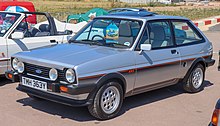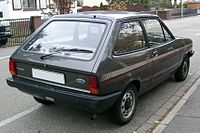
The Ford Kent is an internal combustion engine from Ford of Europe. Originally developed in 1959 for the Ford Anglia, it is an in-line four-cylinder overhead-valve–type pushrod engine with a cast-iron cylinder head and block.

The Ford Fiesta is a supermini car that was marketed by Ford from 1976 to 2023 over seven generations. Over the years, the Fiesta has mainly been developed and manufactured by Ford's European operations, and had been positioned below the Escort.

The Metro is a supermini car, later a city car that was produced from 1980 to 1998, first by British Leyland (BL) and later by the Rover Group. It was launched in 1980 as the Austin Mini Metro. It was intended to complement and eventually replace the Mini, and was developed under the codename LC8. The Metro was named by What Car? magazine as "Car of The Year" in 1983 as an MG, and again as the Rover Metro in 1991.
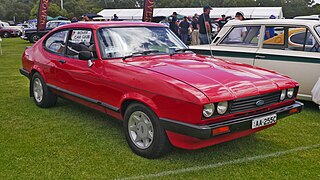
The Ford Capri is a fastback coupé built by Ford of Europe, designed by Philip T. Clark, who was also involved in the design of the Ford Mustang. It used the mechanical components from the Mk2 Ford Cortina and was intended as the European equivalent of the Ford Mustang. The Capri went on to be highly successful for Ford, selling nearly 1.9 million units in its lifetime. A wide variety of engines were used in the car throughout its production lifespan, which included the Essex and Cologne V6 at the top of the range, while the Kent straight-four and Taunus V4 engines were used in lower-specification models. Although the Capri was not officially replaced, the second-generation Probe was effectively its replacement after the later car's introduction to the European market in 1994.

The Ford Corcel is a family car which was sold by Ford do Brasil in Brazil, Chile, Uruguay, Paraguay and Venezuela. It was also assembled in Venezuela. The French-influenced styling of the Corcel was unique to Brazil until late 1977. From this year, the redesigned Corcel II bore a strong resemblance to the European Ford Escort and Ford Cortina of same era, but its Renault underpinnings remained the same. The Corcel was eventually replaced by the Del Rey, which was originally introduced as a better equipped version of the Corcel.

The Ford Fairmont is a model line of compact cars that was manufactured by Ford from the 1978 to 1983 model years. The successor of the Ford Maverick, the Fairmont marked the third generation of compact sedans sold by Ford in North America. Initially slotted between the Pinto and Granada within the Ford line, the Fairmont was later marketed between the Ford Escort and Ford LTD. In contrast to its predecessor, the model line was offered as a two-door notchback sedan, two-door coupe, four-door sedan, and five-door station wagon. Though never sold as a Lincoln, Mercury sold a divisional counterpart of the Fairmont as the Mercury Zephyr.

Carrozzeria Ghia SpA is an Italian automobile design and coachbuilding firm, established by Giacinto Ghia and Gariglio as "Carrozzeria Ghia & Gariglio". The headquarters are located at Corso Guglielmo Marconi, 4, Turin. The company is currently owned by Ford Motor Company and focused on the European market through Ford's subsidiary in the region.
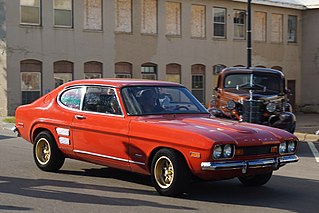
Capri is a nameplate marketed by the Lincoln-Mercury division of Ford Motor Company over three generations between 1970 and 1994.

The Ford Escort is a small family car that was manufactured by Ford of Europe from 1968 until 2000. In total there were six generations, spread across three basic platforms: the original, rear-wheel-drive Mk.1/Mk.2 (1968–1980), the "Erika" front-wheel-drive Mk.3/Mk.4 (1980–1992), and the final CE-14 Mk.5/Mk.6 (1990–2002) version. Its successor, the Ford Focus, was released in 1998, but the final generation of Escort was phased out gradually, with the panel van version ending production in 2002 in favour of the Ford Transit Connect.
1983 in motoring deals with developments in the automotive industry throughout 1983 by various automobile manufacturers, grouped by country. The automotive industry designs, develops, manufactures, markets, and sells motor vehicles, and is one of the Earth's most important economic sectors by revenue.

The Volkswagen Golf Mk2 is a hatchback, the second generation of the Volkswagen Golf and the successor to the Volkswagen Golf Mk1. It was Volkswagen's highest volume seller from 1983 and ended in (German) production in late 1992, to be replaced by the Volkswagen Golf Mk3. The Mk2 was larger than the Mk1; its wheelbase grew slightly, as did exterior dimensions. Weight was up accordingly by about 120 kg (260 lb). Exterior design, developed in-house by VW design director Schäfer, kept the general lines of its Giugiaro-designed predecessor, but was slightly more rounded. All told, about 6.3 million second-generation Golfs were built.
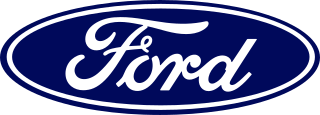
Ford of Europe GmbH is a subsidiary company of Ford Motor Company founded in 1967 in Cork, Ireland, with headquarters in Cologne, Germany.
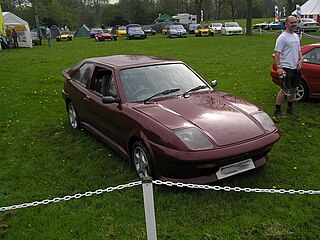
Quantum Sports Cars was founded by Mark and Harvey Wooldridge in 1987.

The Ford Falcon (XD) is a full-size car that was produced by Ford Australia from 1979 to 1982. It was the first iteration of the fourth generation of the Falcon and also included the Ford Fairmont (XD)—the luxury-oriented version.

The Ford Mondeo I (first generation) is a mid-size car that was produced by Ford, beginning on 23 November 1992, with sales beginning on 22 March 1993. It is also known as the Mk I Mondeo; the 1996 facelift versions are usually designated Mk II. Available as a four-door saloon, a five-door hatchback, and a five-door estate, all models for the European market were produced at Ford's plant in the Belgian city of Genk. In December 1992, Autocar published a section on the Mondeo, and how it would conquer rivals.

The Ford Capri (SA30) is an automobile which was produced by Ford Australia from 1989 to 1994. The launch of the car marked a revival of the Ford Capri name, previously used by Ford of Europe from 1969 to 1986 and Ford USAs, Mercury Division, on their Fox-bodied, Mercury Capri, from 1979 to 1986.

The Ford Fiesta Mk2 was the second generation of the Ford Fiesta supermini built by Ford Europe. Originally introduced in 1983, it was a mild facelift of the original car, with some re-engineering to accept an expanded range of engines and it was available in 3-door hatchback and panel van styles. It was replaced by the heavily updated Fiesta Mk3 for 1989.

The Fiesta Mark IV was launched in October 1995 and became Britain's best-selling car from 1996 to 1998, when it was overtaken by the all-new Ford Focus, a replacement for the Ford Escort.

The Ford Fiesta Mk5 is the fifth generation of the Ford Fiesta supermini built in Europe between April 2002 and 2008. The Fiesta continued to be built in Mexico until 2010 and in Brazil until 2014. Most engines were carried over from the previous Fiesta. This generation became the best-selling Ford Fiesta generation to date. This was the first Fiesta to be sold in Asia and Australasia, where it replaced the Kia-based Festiva.
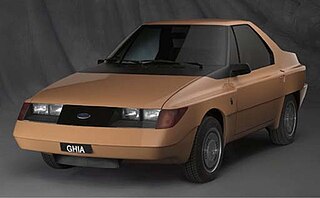
The Ghia Microsport, sometimes referred to as the Ford Microsport, was a one-off concept car created by Italian design studio Ghia as a part of Ford of Europe's design operation, used as a prototype test bed for reducing aerodynamic drag and cutting weight, and displayed at the 1978 Turin Auto Show. After Ford reduced the size of the Ghia studio in Turin, this car was sold as part of "Unique Design Prototype and Concept Auto Show Models from the Ford Motor Company Collection" auction and was on display at Ford World Headquarters in Dearborn, Michigan as part of the Ford Centennial celebrations.

